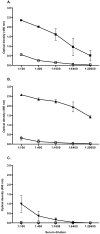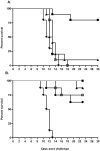The terminal portion of leptospiral immunoglobulin-like protein LigA confers protective immunity against lethal infection in the hamster model of leptospirosis
- PMID: 17629368
- PMCID: PMC1994161
- DOI: 10.1016/j.vaccine.2007.05.053
The terminal portion of leptospiral immunoglobulin-like protein LigA confers protective immunity against lethal infection in the hamster model of leptospirosis
Abstract
Subunit vaccines are a potential intervention strategy against leptospirosis, which is a major public health problem in developing countries and a veterinary disease in livestock and companion animals worldwide. Leptospiral immunoglobulin-like (Lig) proteins are a family of surface-exposed determinants that have Ig-like repeat domains found in virulence factors such as intimin and invasin. We expressed fragments of the repeat domain regions of LigA and LigB from Leptospira interrogans serovar Copenhageni. Immunization of Golden Syrian hamsters with Lig fragments in Freund's adjuvant induced robust antibody responses against recombinant protein and native protein, as detected by ELISA and immunoblot, respectively. A single fragment, LigANI, which corresponds to the six carboxy-terminal Ig-like repeat domains of the LigA molecule, conferred immunoprotection against mortality (67-100%, P<0.05) in hamsters which received a lethal inoculum of L. interrogans serovar Copenhageni. However, immunization with this fragment did not confer sterilizing immunity. These findings indicate that the carboxy-terminal portion of LigA is an immunoprotective domain and may serve as a vaccine candidate for human and veterinary leptospirosis.
Figures






Similar articles
-
Immunoprotective properties of recombinant LigA and LigB in a hamster model of acute leptospirosis.PLoS One. 2017 Jul 13;12(7):e0180004. doi: 10.1371/journal.pone.0180004. eCollection 2017. PLoS One. 2017. PMID: 28704385 Free PMC article.
-
A LigA three-domain region protects hamsters from lethal infection by Leptospira interrogans.PLoS Negl Trop Dis. 2011 Dec;5(12):e1422. doi: 10.1371/journal.pntd.0001422. Epub 2011 Dec 13. PLoS Negl Trop Dis. 2011. PMID: 22180800 Free PMC article.
-
Evaluation of different strategies to promote a protective immune response against leptospirosis using a recombinant LigA and LigB chimera.Vaccine. 2019 Mar 22;37(13):1844-1852. doi: 10.1016/j.vaccine.2019.02.010. Epub 2019 Feb 28. Vaccine. 2019. PMID: 30826147
-
Leptospiral Immunoglobulin-Like Domain Proteins: Roles in Virulence and Immunity.Front Immunol. 2021 Jan 8;11:579907. doi: 10.3389/fimmu.2020.579907. eCollection 2020. Front Immunol. 2021. PMID: 33488581 Free PMC article. Review.
-
Expansion of the in vitro assay for Leptospira potency testing to other serovars: case study with Leptospira Hardjo.Biologicals. 2013 Sep;41(5):323-4. doi: 10.1016/j.biologicals.2013.06.003. Epub 2013 Jul 6. Biologicals. 2013. PMID: 23838569 Review.
Cited by
-
A conserved region of leptospiral immunoglobulin-like A and B proteins as a DNA vaccine elicits a prophylactic immune response against leptospirosis.Clin Vaccine Immunol. 2013 May;20(5):725-31. doi: 10.1128/CVI.00601-12. Epub 2013 Mar 13. Clin Vaccine Immunol. 2013. PMID: 23486420 Free PMC article.
-
Oral immunization with Escherichia coli expressing a lipidated form of LigA protects hamsters against challenge with Leptospira interrogans serovar Copenhageni.Infect Immun. 2014 Feb;82(2):893-902. doi: 10.1128/IAI.01533-13. Epub 2013 Dec 9. Infect Immun. 2014. PMID: 24478102 Free PMC article.
-
Leptospiral adhesins: from identification to future perspectives.Front Microbiol. 2024 Aug 13;15:1458655. doi: 10.3389/fmicb.2024.1458655. eCollection 2024. Front Microbiol. 2024. PMID: 39206373 Free PMC article. Review.
-
Chimeras could help in the fight against leptospirosis.Elife. 2018 Jan 19;7:e34087. doi: 10.7554/eLife.34087. Elife. 2018. PMID: 29350615 Free PMC article.
-
Acquisition of negative complement regulators by the saprophyte Leptospira biflexa expressing LigA or LigB confers enhanced survival in human serum.Immunol Lett. 2016 May;173:61-8. doi: 10.1016/j.imlet.2016.03.005. Epub 2016 Mar 11. Immunol Lett. 2016. PMID: 26976804 Free PMC article.
References
-
- WHO Leptospirosis worldwide, 1999. Wkly Epidemiol Rec. 1999;74(29):237–42. - PubMed
-
- Bharti AR, Nally JE, Ricaldi JN, Matthias MA, Diaz MM, Lovett MA, et al. Leptospirosis: a zoonotic disease of global importance. Lancet Infect Dis. 2003;3(12):757–71. - PubMed
-
- Faine SB, Adler B, Bolin C, Perolat P. Leptospira and leptospirosis. 2nd ed. MediSci; Melbourne, Australia: 1999.
-
- Farr RW. Leptospirosis. Clin Infect Dis. 1995;21(1):1–8. - PubMed
Publication types
MeSH terms
Substances
Grants and funding
LinkOut - more resources
Full Text Sources

